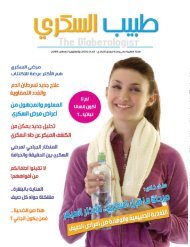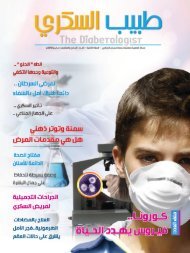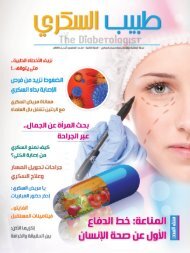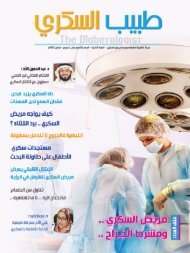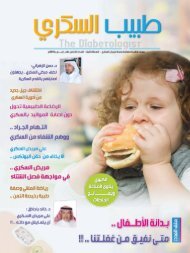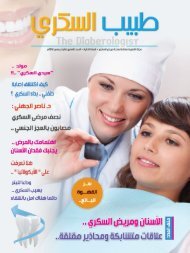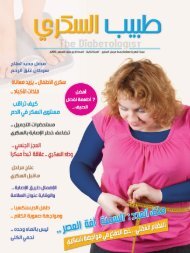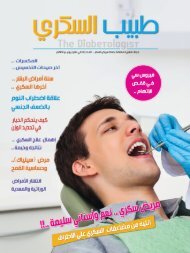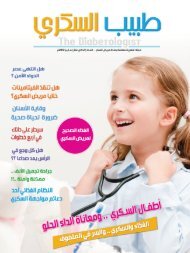The Diabetologist #5
طبيب السكري - العدد 5
طبيب السكري - العدد 5
You also want an ePaper? Increase the reach of your titles
YUMPU automatically turns print PDFs into web optimized ePapers that Google loves.
IBS diagnostic algorithm<br />
FBC, full blood count; FOBT, fecal occult blood test; ESR, erythrocyte<br />
sedimentation rate.<br />
< Where relevant—i.e., when there is a high prevalence of celiac<br />
disease, parasitosis, and inflammatory bowel disease or lymphocytic<br />
colitis, respectively.<br />
IBS diagnostic cascade<br />
Level 1<br />
History, physical examination, exclusion of alarm symptoms, consideration<br />
of psychological factors<br />
Full blood count (FBC), erythrocyte sedimentation rate (ESR) or<br />
C-reactive protein (CRP), stool studies (white blood cells, ova,<br />
parasites, occult blood)<br />
Thyroid function, tissue transglutaminase (TTG) antibody<br />
Colonoscopy and biopsy*<br />
Fecal inflammation marker (e.g., calprotectin)<br />
Level 2<br />
History, physical examination, exclusion of alarm symptoms, consideration<br />
of psychological factors<br />
FBC, ESR or CRP, stool studies, thyroid function<br />
Sigmoidoscopy*<br />
WGO Practice Guideline Irritable bowel syndrome 9 Level 3<br />
History, physical examination, exclusion of alarm symptoms, consideration<br />
of psychological factors<br />
FBC, ESR, and stool examination<br />
* N.B. Even in “rich” countries, not all patients need coloscopy—in<br />
particular, those with alarm symptoms and signs and those over<br />
the age of 50. <strong>The</strong> need for investigations and for sigmoidoscopy<br />
and colonoscopy, in particular, should also be dictated by the<br />
characteristics of the patient (presenting features, age, etc.) and<br />
the geographical location (i.e., whether or not in an area of high<br />
prevalence of inflammatory bowel disease, celiac disease, colon<br />
cancer, or parasitosis). One could argue, for example, that a 21-<br />
year-old woman with symptoms of IBS-D and no alarm features<br />
merits, at most, celiac serology (where appropriate).<br />
3 Evaluation of IBS<br />
A diagnosis of IBS is usually suspected on the basis of the patient’s<br />
history and physical examination, without additional tests.<br />
Confirmation of the diagnosis of IBS requires the confident exclusion<br />
of organic disease in a manner dictated by an individual patient’s<br />
presenting features and characteristics. In many instances<br />
(e.g., in young patients with no alarm features), a secure diagnosis<br />
can be made on clinical grounds alone.<br />
<strong>The</strong> following may be useful in<br />
providing an objective assessment<br />
of psychological features:<br />
Hospital Anxiety and Depression<br />
Scale (HADS). This is a simple 14-<br />
item questionnaire to measure the<br />
level of anxiety and depression.<br />
<strong>The</strong> Sense of Coherence (SOC) test<br />
can be used to identify patients with<br />
a low SOC who respond to cognitive<br />
behavioral therapy.<br />
<strong>The</strong> Patient Health Questionnaire<br />
(PHQ-15). This is a 15-item questionnaire<br />
that helps identify the presence<br />
of multiple somatic symptoms<br />
(somatization). <strong>The</strong> PHQ-15 should<br />
be validated in a given country before<br />
it is used in clinical practice in<br />
that location.<br />
Physical examination<br />
A physical examination reassures<br />
the patient and helps to detect possible<br />
organic causes.<br />
A general examination is carried out<br />
for signs of systemic disease.<br />
Abdominal examination: — Inspection<br />
— Auscultation — Palpation<br />
Examination of the perianal region:<br />
— Digital rectal examination.<br />
04<br />
issue 5 < Oct. - Nov. 2011






